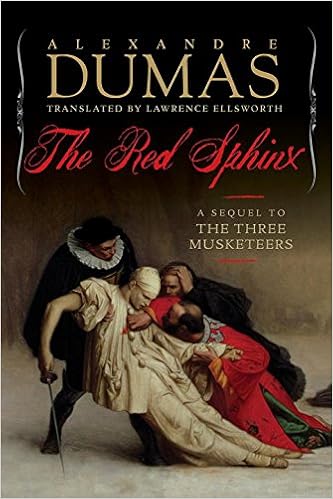Dirda writes about the Red Sphinx in the Washington Post:
Originally called “The Comte de Moret,” “The Red Sphinx” first appeared during 1865 in Les Nouvelles, but it was never quite completed after the magazine folded. For this handsome new edition — the work’s first translator since a wretched 19th-century version — Lawrence Ellsworth appends a related novella titled “The Dove,” which brings the adventures of the Comte de Moret and his beloved Isabelle de Lautrec to a dramatic, nick-of-time close.
Yet the Red Sphinx himself, as the historian Michelet dubbed Cardinal Richelieu, wholly dominates the book’s 800-plus pages. The action begins in December 1628, shortly after the French victory at La Rochelle chronicled in “The Three Musketeers.” A mysterious cloaked hunchback tries to hire a down-on-his luck swordsman named Latil to murder the Comte de Moret. That young man, the illegitimate son of the late Henri IV, has just arrived in Paris from Italy, bearing secret letters for Marie de Medici, Anne of Austria and Gaston, the duc d’Orleans, respectively the queen mother, the queen and King Louis XIII’s brother (and would-be successor). When Latil refuses to be an assassin, a quarrel develops, the hunchback’s three companions join the fray and the swordsman is left for dead.
. . . . In the final third of this continually enjoyable novel, the action moves to the battlefield, as the armies of France enter Italy. Here several guerrilla operations behind the lines should thrill even fans of Bernard Cornwell. Here, too, Richelieu encounters a young papal officer named Mazarino Mazarini, who will eventually become a French citizen and ultimately Richelieu’s successor, Cardinal Mazarin.. . . . I so admire Dumas as an historical novelist and his methodology for creating historical fiction. He knew his history and researched constantly. He really knew what he was doing, by which I mean he consciously constructed a set of tools by which he thought the sort of historical fiction he was writing -- which he and the father of historical fiction, Sir Walter Scott -- called Romance -- and matter-of-factly employed them day in and day out. Despite his love for Romance fiction, he didn't regard writing as an activity of Romance, but one of a job that provided an excellent living.




No comments:
Post a Comment